Similar Posts
On the 27th of November 2019, Father Sophrony, founder of the Community of St. John the Baptist in Essex, England; monk, spiritual father, theologian, and iconographer, was numbered among the saints with the name St. Sophrony the Athonite. This was not unexpected as there had been rumors earlier, but still, it changed my life.
I joined Father Sophrony’s monastery in 1983 just before the start of a major painting project: the murals of the chapel of St. Silouan the Athonite. I worked with Father Sophrony on the murals and also on several icons, mosaics and projects. One project was to paint his own Elder, St. Silouan, when he was entered into the list of saints. Then, as happened now, there had been strong rumors of his canonization so we dared to start the icon but left it without a name. We added the name the evening we received confirmation and put the icon in the iconostasis of the chapel.
Father Sophrony used to tell how his Elder was a constantly praying person and that his facial expression changed continuously, reflecting his inner life. He also said that no photograph gave him justice as the photograph is taken in a split second and does not reflect or represent the full person. On the other hand, an icon has to be a portrait of the inner and outer man. Little did I know that thirty years later I would find myself in the same position of painting my Elder.
From reading his life, it is clear that he was one of God’s elect who was deemed worthy to see the Glory of the Lord, and as such, his face was continually “transformed into the same image from glory to glory, even as by the Spirit of the Lord.” For this reason, it is very difficult to depict his face as an icon.
Before I began my work on an icon of St Sophrony, others were in existence; but there were few with which I could identify. Many of them looked like caricatures or were copied from photographs or exaggerated his expression around the mouth. Others represented him in his winter coat holding one of the buildings of his monastery. Another widely circulating image was of St Sophrony holding a chalice, but I remembered that a renowned iconographer had spoken strongly against icons of St John of Kronstadt holding a chalice, saying that the chalice cannot be attributed to any particular saint as all ordained clergy hold the chalice. So, at first, there was no obvious solution for me. Therefore, I surrounded myself with several photographs, prayed and started by asking St Sophrony to help me paint an icon to his liking.
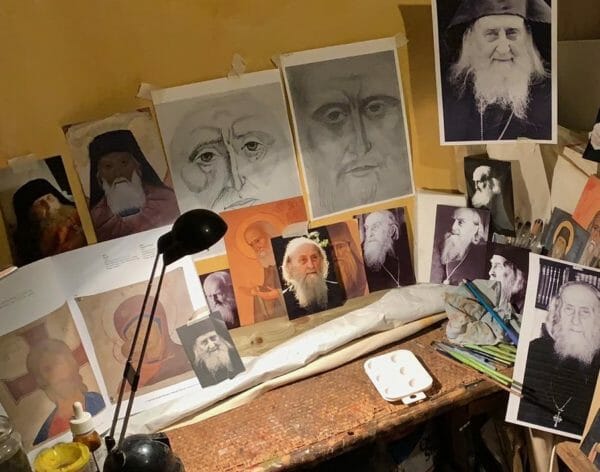
My working table with photos of St Sophrony
I settled on three main types of icons:
- As a great schema monk holding a scroll or an icon.
- As a hieromonk (with rasson and epitrachelion) holding a scroll.
- In full vestments, holding a Gospel open at a relevant page.
For the first icon, I painted St. Sophrony in monks’ clothing, his right hand blessing and his left hand holding the icon of his Elder. Making St. Silouan known to the Orthodox Church, to monasticism and to the whole world, was something that St. Sophrony himself considered to be the main purpose of his life. I worked for a long time and with much fear during all of Great Lent 2019. It was then that I encountered my main problem: how to present the color of his eyes which I remembered as a clear light blue.
In this first icon, I did not get the color right nor did I succeed with the physical resemblance. However, it felt like an icon to me and when the time came, we placed it in the chapel of St Silouan under the icon that St Sophrony had painted of his Elder.
Next, I painted a smaller icon of St Sophrony holding a scroll, in order to write some of his own words on the icon. I intended this icon to be more personal and represented him bareheaded wearing the epitrachelion that had been embroidered especially for him in the 1960’s with the special symbol of the monastery on it. People who knew Father Sophrony’s dislike for kitsch criticized me for this icon. Again, I painted the eyes blue, but they turned dark under the linseed varnish; so, I learned that I needed to block out the olive green of the sankir with white in order to obtain a clear blue. On the whole, I was less happy with this icon as I considered it to be less iconographic and more photographic in style.
The two icons above were done in secret in my cell before Father Sophrony was numbered among the saints when I was at my ease having all the time in the world. But after the announcement, the situation changed; suddenly we needed more icons for several places.
First, an icon was needed on top of St Sophrony’s tomb. As it was urgent, I resorted to my pastel technique. I dressed him in full liturgical vestments and modeled them on the very vestments in which he had been buried, holding a Gospel book open to a relevant quote. The likeness of the face is marginal and the eyes are blue. This time the acrylic varnish intensified the color and once more the eyes became too dark.
The crypt where St Sophrony is buried had a mosaic crucifix as the sole iconographic decoration on the east wall. I suggested we add him interceding for the world at the feet of the crucified Christ. In order to determine the possibility of a future mosaic, I made a pastel study and adhered it to the wall. Here, I think both likeness and eye color are better than before.
But once it was mounted in the crypt, it looked too asymmetrical so a study of St Silouan was added to the other side of the cross.
At this point, my question about blue eyes reached a peak. Years before, when a Russian iconographer was visiting, Father Sophrony asked him to paint a large icon of St. Silouan and he wanted him to paint the eyes blue. The iconographer refused and painted the eyes brown. However, since Father had made the request, it must have meant that St. Silouan’s eyes actually were blue. Nevertheless, he himself had painted the eyes of his elder brown in three places: a mural in the refectory, a mural in the chapel of St Silouan and the aforementioned icon of the icon screen.
I started asking all the iconographers I knew their opinion on the matter.
Some, in principle, were against it. Many agreed that if the eyes were blue, then they could be painted as they were. There were some valid points. The best argument against, was that a black and white photograph of a saint would not convey less holiness than a colored one. Others simply said that it was not part of Tradition; but here I have my doubts, because there are old icons with blue grey eyes.
One friend who had just painted an icon of St Porfyrios, who also had blue eyes, suggested to keep the color a discrete blue, more towards the gray tone.
The next task was to paint our saint in our two refectories. The walls of the newer one had been painted in real fresco, in the Athonite style with standing monastic saints. Luckily, the saint who stood next to St. Silouan was S.t Theophan the Recluse who had several physical similarities with St. Sophrony. Therefore, we decided to “re-morph” him using egg tempera on top of the fresco. I locked myself into the refectory one Sunday night, blocked out the parts of the face that needed changing with titanium white and painted on top. In this case, the eyes became too blue.
Afterwards, the most difficult work remained: to paint St Sophrony in the refectory which contains his own wall paintings, to paint him in his own style.
This was the time I learned the most. I found a photo of him which corresponded exactly to the position needed. I enlarged it and started working again in pastel. Almost immediately, I realized that it was impossible to work with the real features; they had to be given iconographic exaggerations. I cannot describe how the work went. I prefer just to illustrate with gradual photographs; but the result was something beyond me. I felt for the first time I was getting near to something more true. But it was not possible to make the eyes blue. Initially I did, but they did not fit into the general style of the murals. Although Father Sophrony himself had painted some of the Apostles’ eyes on the Last Supper in blue.
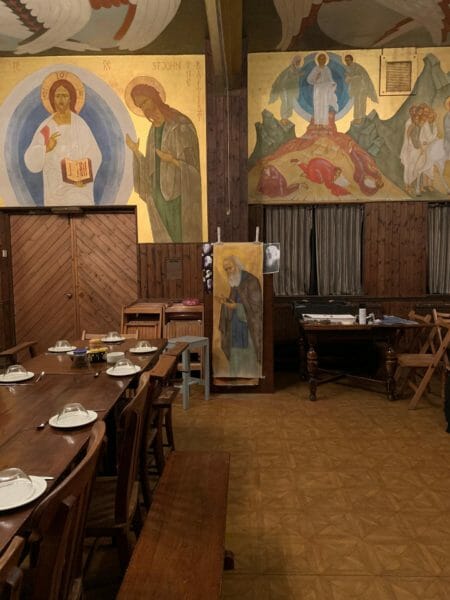
Developing final details in situ
Since that day, I have painted many more icons of St Sophrony, some with monastic hat, some bareheaded, but always continuing to try to capture the correct blue eyes and at the same time striving to paint a worthy inner portrait, a true icon.
Perhaps it will be necessary to continue this search for the rest of my life. I hope one day to succeed. However, I would be very grateful for any thoughts about this matter from my fellow iconographers.
In all the works described above, I found that St Sophrony both supported and assisted me. For this reason, now that he has been officially glorified, he will surely be encouraging and helpful to all iconographers.
For an illustration of his own works, see the two volumes of his catalogue raisonné:
https://www.amazon.com/dp/1909649236
https://www.amazon.com/dp/1909649422
And our extensive article about St. Sophrony’s artistic work: Seeking Perfection in the World of Art: The Artistic Path of Father Sophrony

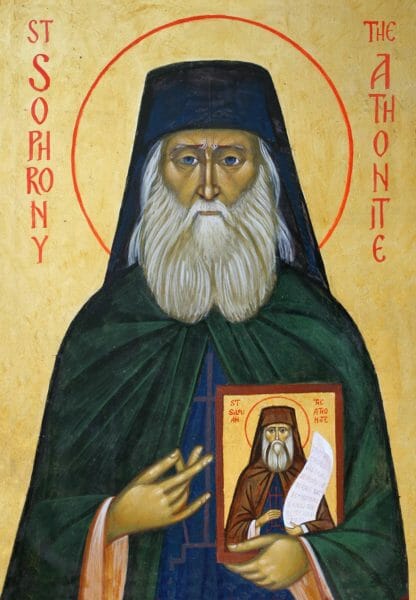
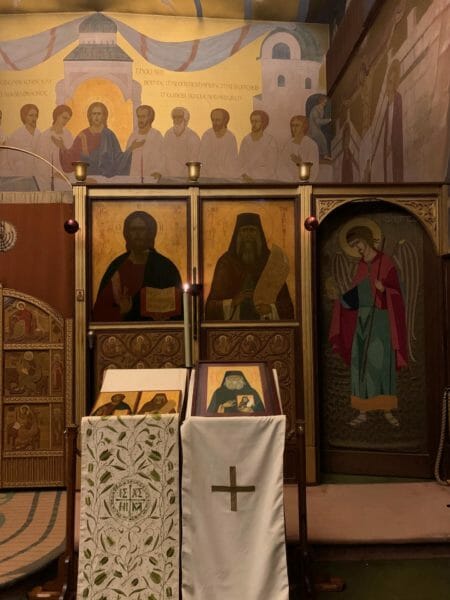
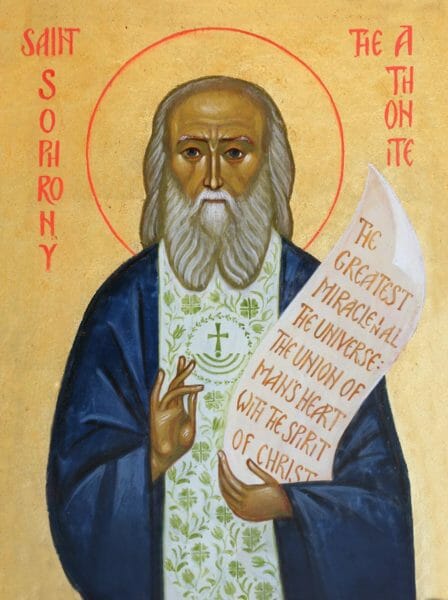
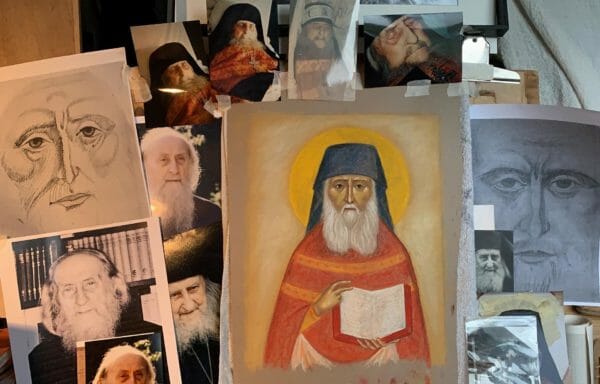
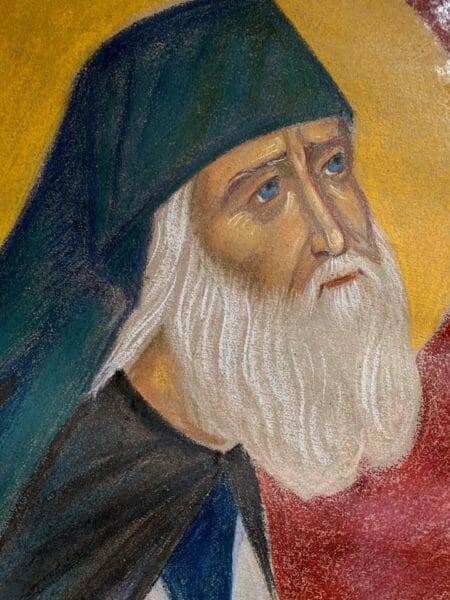
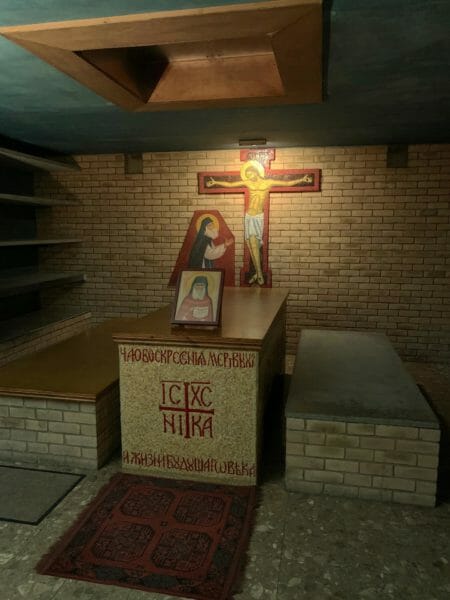
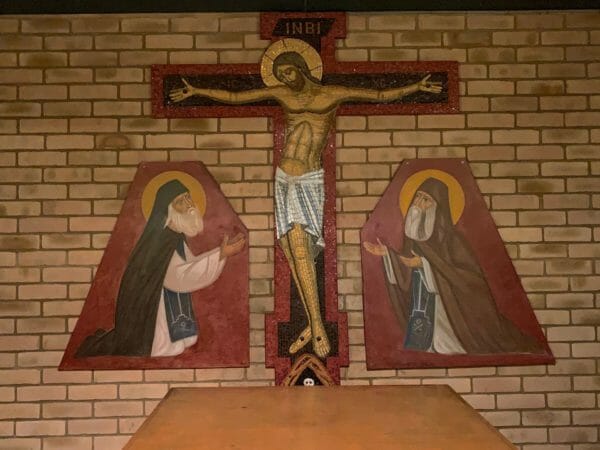
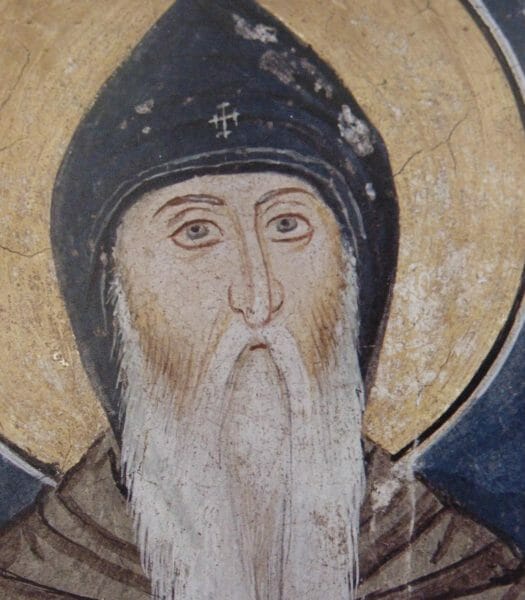
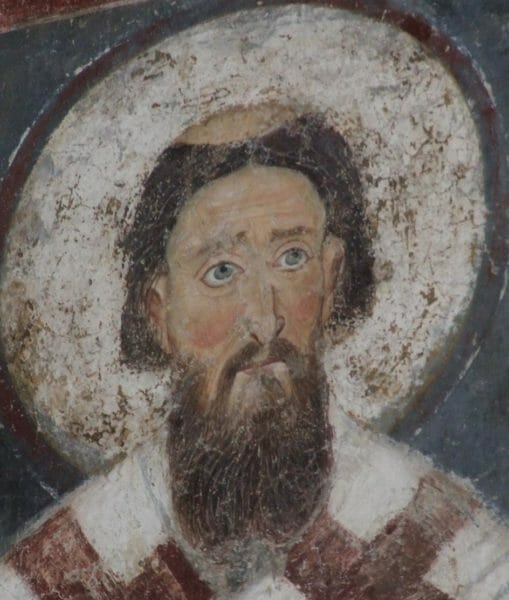
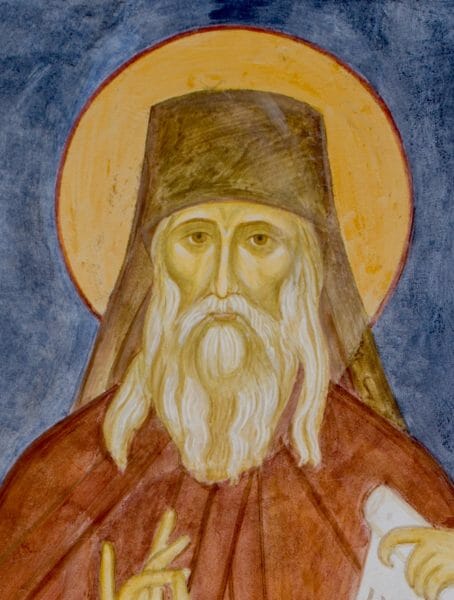
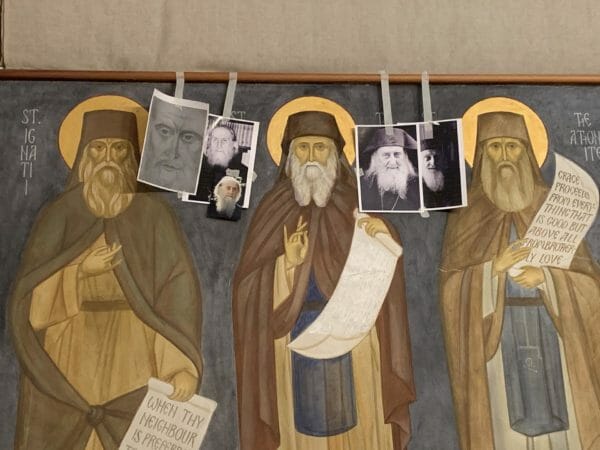
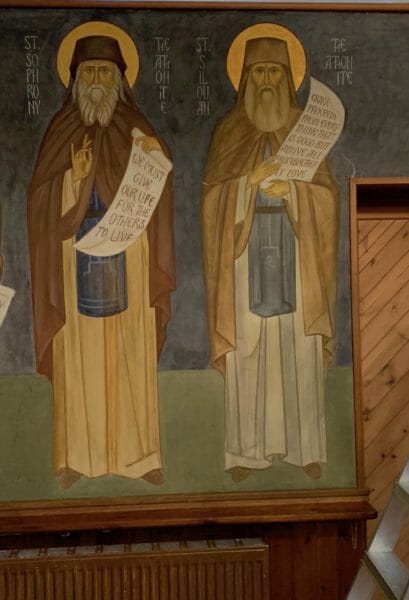
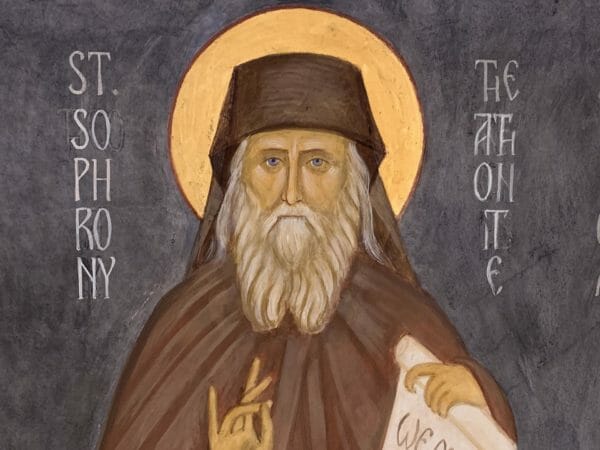
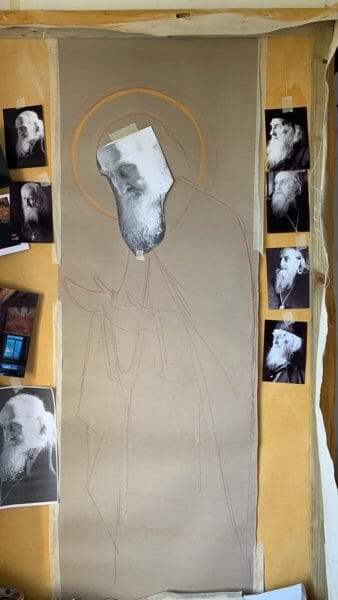

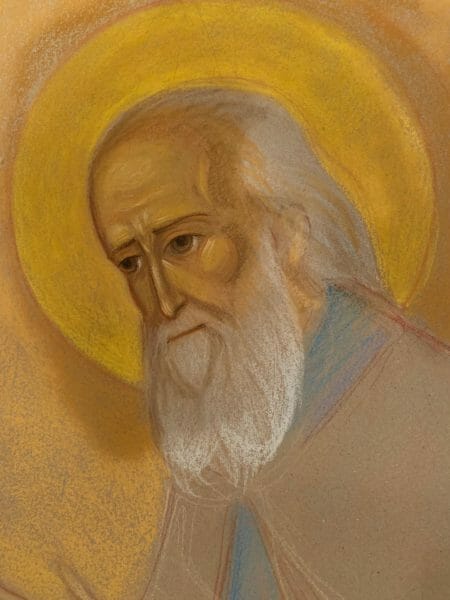
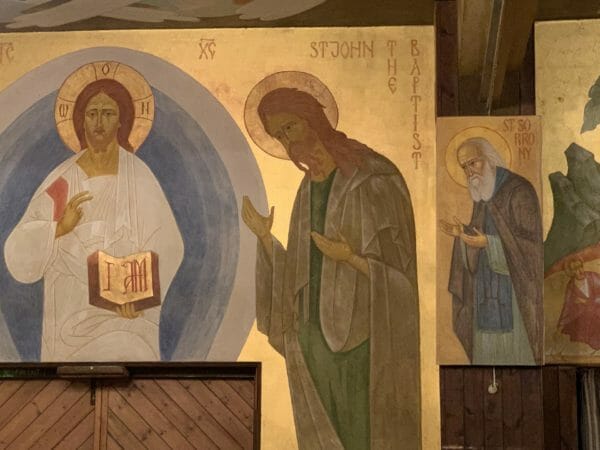
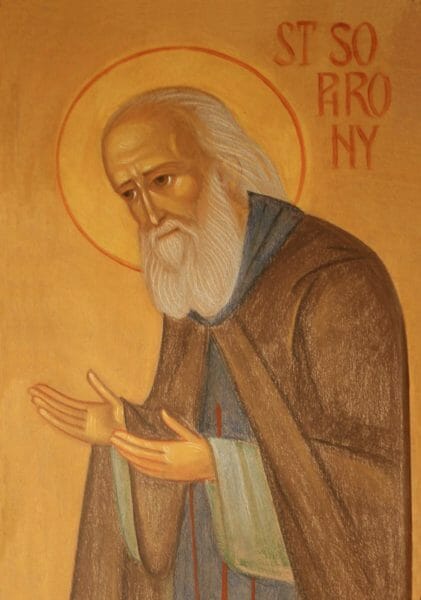
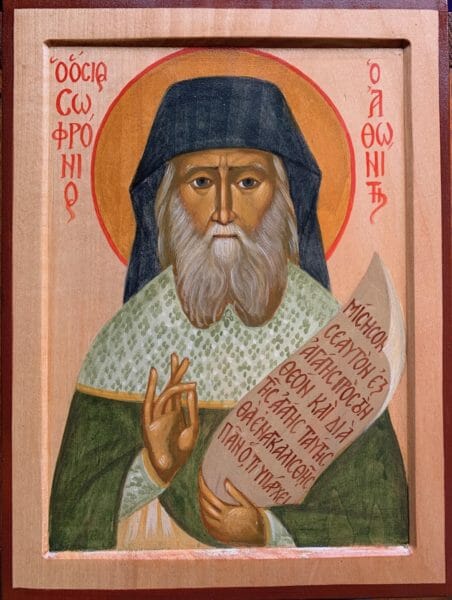
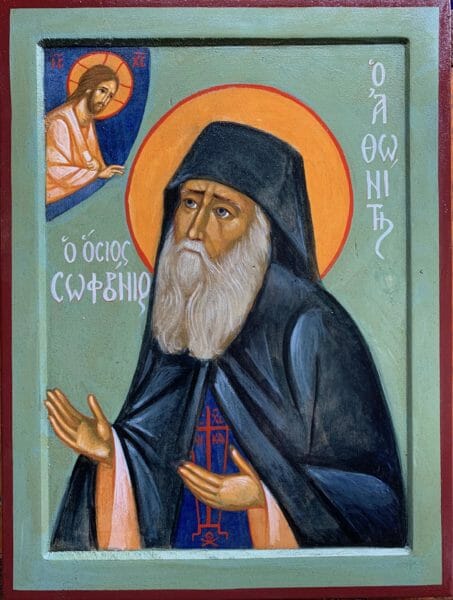
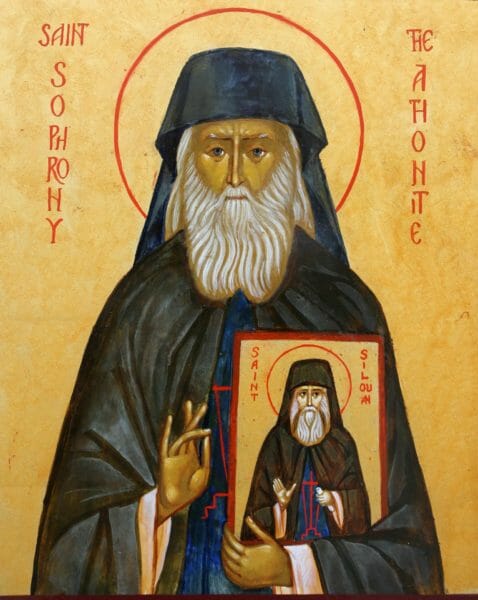
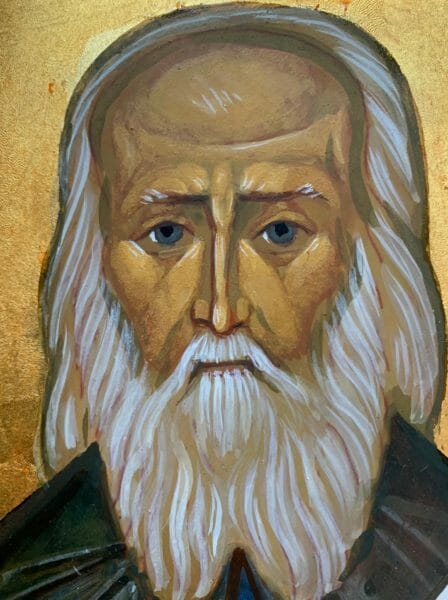
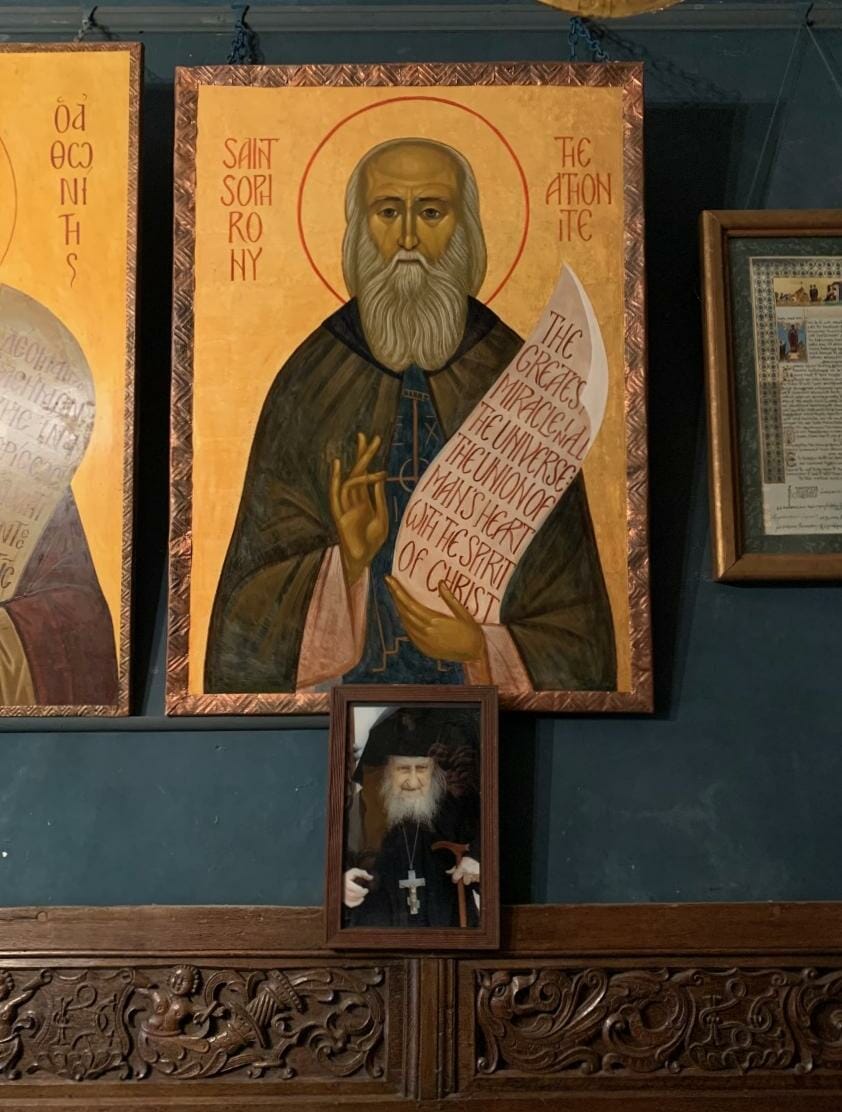
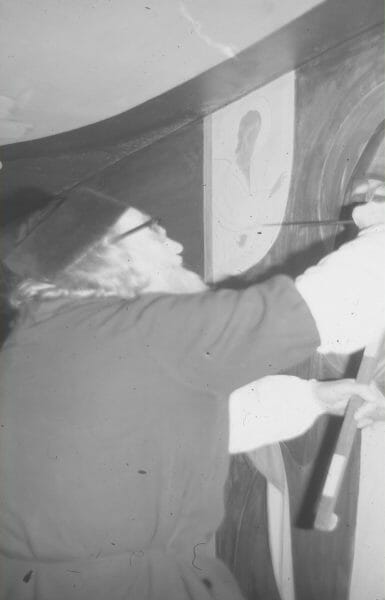
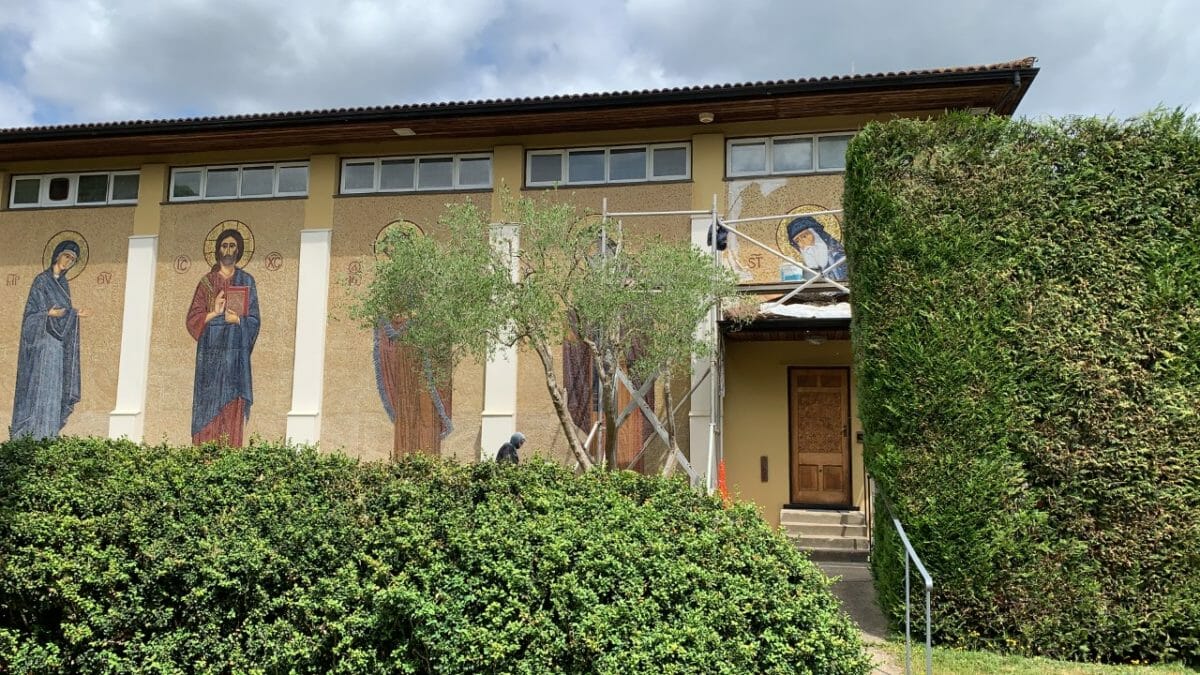
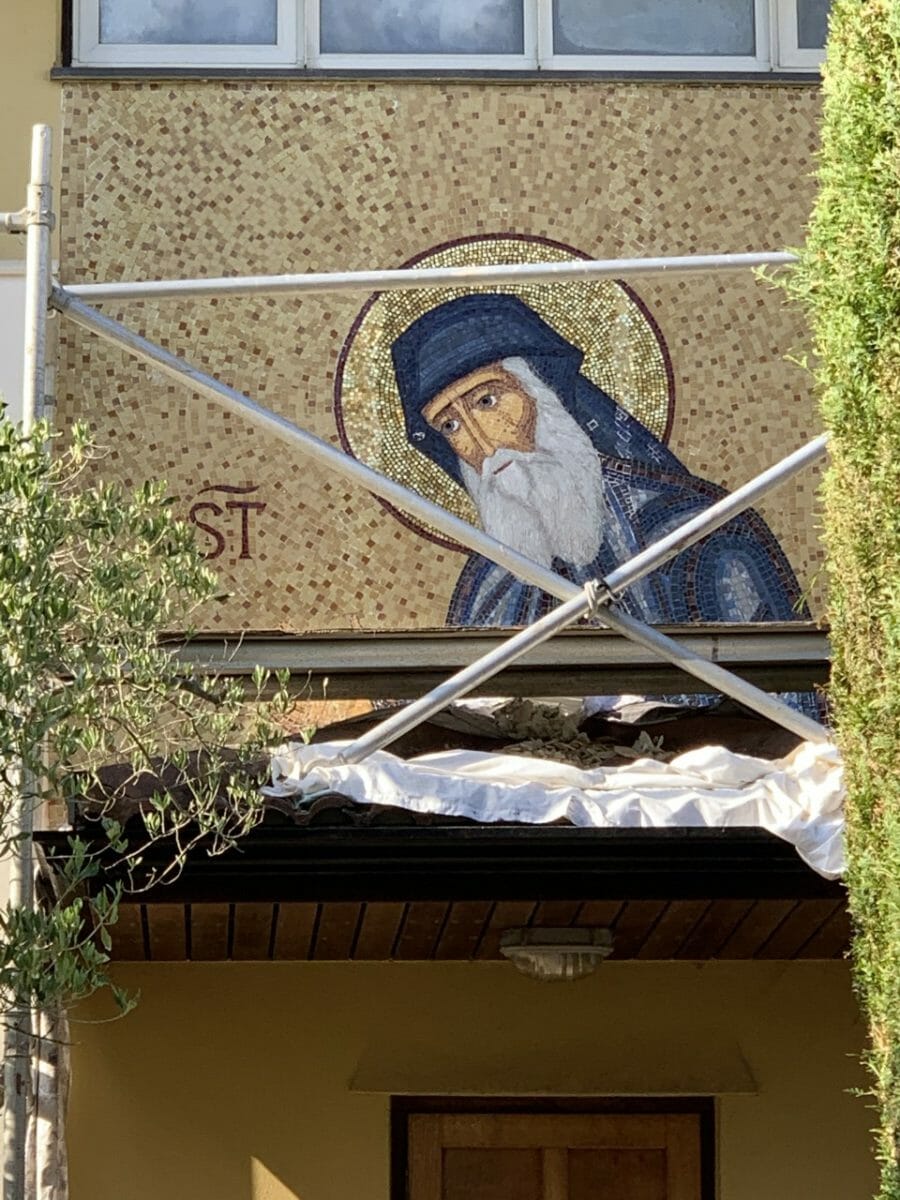
These are so beautiful! I have an icon of him and he has helped me so much in my spiritual life. Will any be for sale?
This is a superb article which both expresses love and gratitute to Father Sophrony, AND clearly expresses any iconographer’s search for the right representation of the saint they are portraying. I find this very assuring.
In a way it reminded me of being on a quest to paint an icon of St. Genevieve, from whom my wife took her Saint’s name. I read a comment by Gregory Krug that he searched for months to find the right color for the background of an icon of St Genevieve.
At that time my wife couldn’t understand why there is difficulty painting a saint, but I think here you have summed up the challenge, for which we have to seek inspiration.
Thank you
What a gift and a challenge to paint icons of someone you knew in life! I am a beginner and thus my observations do not count for much. All of your icons are beautiful but I particularly love your work in pastels. Different mediums seem to capture different things and there is a softness in your pastels that seem to communicate a gentleness, a prayerfulness that match your description of the saint in words. Thank you.
Sister Gabriela has told me that she invites critical comments, as she wishes for feedback that will lead to improvement in her efforts to paint Saint Sophrony. So I will offer her my own thoughts.
I wonder, Sr. Gabriela, if you are trying too hard to stylize him and make him look like an ordinary icon. I feel there is room for him to look more distinctively like himself. He was a pretty distinctive looking man, with his big nose and mischievous smile – sort of like a playful leprechaun, to my eyes, as one who knows him only from photographs. I think your icons would be more satisfying with a little more of this character.
While it is true that most icons, to a certain extent, make everyone look the same, I suspect this is just due to the memory of their subjects’ particular appearance being forgotten over the passage of time. There are historic examples of icons painted within a saint’s living memory, and these sometimes show the saint with a very distinctive appearance. The fresco of St. Sava that you include in your article is a perfect example of this. And in this age of photographs, where a saint’s exact appearance will never be forgotten, I think it is all the more important to make sure that the icons correspond convincingly with the photographs, and that the icons do not seem generic by comparison.
Of course, this can go to far. A naturalistic likeness can also be distracting in an icon, and Byzantine perspective and stylization serves several helpful purposes, but surely, the right balance can be found, where the icon and the photograph seem like two sides of the same coin.
Dear Andrew,
Thank you very much for such a constructive and helpful comment.
I will follow it up.
sr Gabriela
Dear Sister Gabriela
Thank you for this very interesting description of your efforts towards finding the best solution for an icon of Saint Sophrony. – We in Denmark are very glad that St. Sophrony, whom some of us have met personally at the monastery, is now numbered among the Saints of the Church.
I have a question: Must the icon bear the official name, “Saint Sophrony the Athonite”? Or would it be permissible to write “Saint Sophrony of Essex”? – We have discussed this in our parish and with our local iconographer. If “the Athonite” is used, many will not know who this is, but if “of Essex” is used, many will immediately know whom the icon is referring to. – Maybe a compromise would be admissible, “Saint Sophrony the Athonite from Essex”?
Thank you beforehand, Sr. Gabriela, for your comments on this.
In Christ
Fr. Poul Sebbelov
Parish of the Protection of the Mother of God
Copenhagen, Denmark
Dear Father Poul,
The “subtitle” was given by the Patriarch in the act of him being added into the calendar of saints. There were many different thoughts going around wondering which “subtitle” be would receive. “Of Essex” was one, “Theologian of the Uncreated Light” was another, etc. Personally we hoped it would not be “of Essex” for many reasons, one of them is that locally it has not got a good association. When we heard “the Athonite” we were first a little surprised, but then realised that this is what Fr Sophrony himself would have wanted. He always considered himself a monk of Mount Athos and how he founded and arranged our life in the monastery was all based on his different experiences from his time on Mount Athos. He himself would have liked to return there, but life turned out differently. Also, like this he is more united with St Silouan, another aspect that he would have liked more than anything else. I hope that this helps?
Your Blessing,
Sr Gabriela
Thank you, Sr Gabriela, for sharing your insights into this decision. It is important for people to know this reasoning, because some have assumed it was a sort of political move to Hellenize him – to downplay the English connection.
Nevertheless, I am not sure everyone should feel obliged to use official forms of titles even if there’s good reason for them. Had St. Herman been canonized St. Herman the Valaamite, you can be sure that everyone would still call him St. Herman of Alaska, as they already had for centuries. I can understand that those of you who live in Essex would not call yourselves ‘of Essex’. But in the rest of the world, for whatever reason, people often call your monastery ‘the Essex Monastery’. It may not be logical, but it’s what people are used to. Therefore I think it is inevitable that some will use this title for St. Sophrony, and that he will end up being one of those saints who has multiple titles, like St. John the Theologian/the Divine/the Beloved/of Patmos.
May God bless!
Dear Sr Gabriela
Thank you very much for your explaining the process which led to the subtitle “the Athonite” for the icon of St. Sophrony. It is certainly helpful.
I realize, of course, the importance of stressing St. Sophrony’s lifelong attachment to Mount Athos, and of underlining his close relationship with and inspiration from St. Silouan.
At the same time I still find it very important to not loose sight of what Andrew Gould in his latest comment calls “the English connexion”. For Orthodox Christians in the Western World, many of whom are converts to Orthodoxy, it is essential to become aware that Orthodox spiritual life and even Orthodox Saints are not always elements “from afar”, nor always belonging in “exotic” parts of the world.
Therefore, in my opinion, it would be a good thing if by the “subtitle” used for St. Sophrony a signal could be sent that, in spite of his Russian and Athonite history, the Saint belongs (also) to Western Europe, since he founded and built up his monastery in England, thus opening the way to Orthodoxy for countless “Westerners”.
Our “local” iconographer (from Georgia) has suggested the compromise I mentioned, “Saint Sophrony the Athonite from Essex”. – In your opinion, would such a solution be admissible?
In Christ
Fr. Poul
Denmark
Dear Father Poul,
Your Blessing.
Your points are very valuable and true.
Forgive me, but I find such a long title a bit too much. Better to be simple, with the one name or the other, unless it is for a special icon in a specific location, like for example your church. I do not think that it is something that has to be too rigid, especially not if there is a particular reason, like the one you mention. We, at our monastery, will however keep the original ‘subtitle’.
With great respect,
sr Gabriela
Dear Sr Gabriela,
than you for this great insight. I have not written an icon of the Saint, and by chance came across your wonderful and inspiring article. (God works in mysterious ways)!
I have a little more courage now to attempt a line drawing, please keep me in your prayers.
I hope that one day soon i will come again to the monastery. (I have not forgot your copy of the new book). My kind regards and respect, George
Dear George,
Just today I was thinking of your book and wondering if you finished it as it is the feast of all the saints you depict in there. Please make it known to Orthodox Arts Journal, it will profit many readers and painters.
Info: George has produced a book on the saints of the British Isles based on the model of the Stroganov icon pattern book with line drawings and descriptions of every saint arranged according to the church year. He showed it to me when it was virtually finished and it looked fantastic, an invaluable tool.
sr Gabriela